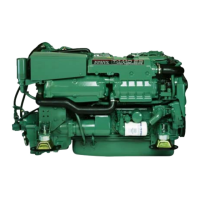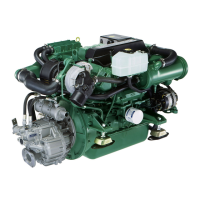Do you have a question about the Volvo Penta TAMD60A and is the answer not in the manual?
Purpose and scope of the instruction book.
Information on Volvo Penta's service network and warranty.
Explains safety symbols and warning levels.
Details engine model naming conventions.
Visual identification of key engine parts through diagrams.
Introduction to instruments and controls.
Checks and preparations before engine ignition.
Step-by-step guide for engine ignition.
Post-ignition checks and initial operation.
Guidance on optimal engine RPM for various conditions.
Procedures for breaking in a new or reconditioned engine.
Procedures for changing engine oil during the break-in period.
Routine checks and observations while the engine operates.
Procedures for safely shutting down the engine.
Engaging emergency mechanical clutch for limited operation.
Steps to prevent frost damage to the cooling system.
Use and necessity of a propeller shaft brake.
Specifications and recommendations for engine and gear oil.
Requirements and quality standards for diesel fuel.
General information on the engine's electrical system.
Visual representations of electrical connections and circuits.
Guidance for new boat owners on safe operation and handling.
Importance of maintenance and safety equipment.
Recommended pre-operation visual checks of the engine and boat.
Safe practices for boat handling, speed, and gear changes.
Precautions during refueling to prevent fire and explosion.
Conditions under which the engine must not be started.
Risks of CO poisoning from exhaust gases and prevention.
Important safety reminders and preparation tips for boat trips.
Essential steps before performing maintenance tasks.
Safety procedures for stopping the engine before service.
Safe methods for lifting and handling the engine.
Warnings and precautions related to flammable materials and ignition sources.
Risks associated with hot engine parts and liquids.
Safe handling and storage of hazardous chemicals.
Precautions when working with the engine's cooling system.
Hazards related to engine oil and lubrication systems.
Precautions for working on the fuel system.
Safety measures for electrical system maintenance.
Hazards and precautions when handling batteries.
Visual identification of key engine parts through diagrams.
Detailed explanation of instrument panel functions.
Details on wet liners, turbocharging, and after-cooling.
Explanation of gauges and indicators on the basic panel.
Optional instrument panel for the flying bridge.
How to operate single and twin lever controls.
How to engage and disengage the clutch.
Tables for cooling system capacity and recommended glycol quantities.
Standards and viscosity grades for engine lubricating oil.
Lubricating oil for reverse gear and hydraulic systems.
Quality demands for diesel fuel oil.
Technical data for the electrical system components.
Routine maintenance tasks to be performed daily.
Maintenance tasks for every 50 operating hours.
Maintenance tasks for every 100 operating hours.
Maintenance tasks for every 200 operating hours.
Maintenance tasks for every 600 operating hours.
Maintenance tasks for every 1200 operating hours.
Maintenance tasks for every 2400 operating hours or as needed.
Daily procedure for checking engine oil level.
Daily procedure for checking reverse gear oil level.
Oil capacity and types for various reverse gears.
Daily procedure for checking engine coolant level.
Lubrication of clutch and reduction gear components.
Checking oil level in the reduction gear.
Checking oil level in the hydraulic system.
Procedures for checking battery electrolyte levels and charge.
Lubricating clutch and reduction gear components.
Checking and replacing fuel filter elements.
Procedure for replacing fuel fine filter elements.
Procedures for bleeding air from the fuel system.
Checking for air leaks in the turbocharger system.
Inspecting and replacing zinc anodes for corrosion protection.
Procedure for replacing engine oil filters.
Procedure for changing oil in the reduction gear.
Checking and adjusting valve clearances.
Replacing the crankcase ventilation filter element.
Cleaning and checking fuel injectors.
Inspecting the cooling system for leaks and blockages.
Checking clutch function and adjusting mechanisms.
Changing oil and filter in the hydraulic system.
Procedure for changing oil in the reverse gear.
Cleaning oil coolers for various reverse gear models.
Cleaning oil coolers for various reverse gear models.
Inspecting the turbocharger for leaks and wear.
Assessing overall engine condition for wear and performance.
Information on cylinder head gaskets and tightening procedures.
Procedures for protecting the engine during extended periods of inactivity.
Detailed technical data for engine models.
Technical specifications for the cooling system.
Technical data for the hydraulic system.
Technical data for the fuel system components.
Technical data for the electrical system components.
Graphs showing turbocharging pressure versus engine speed.
Technical data for Twin Disc and SCG reverse gears.
Technical data for Borg Warner reverse gears.
Key to understanding the main block diagram of the electrical system.
Detailed wiring diagram for TAMD60A and TAMD60B engines.
Detailed wiring diagram for TAMD70C/D and AQD70C/D engines.
Wiring diagram for the basic instrument panel.
Wiring diagram for supplementary instrument panels.
Wiring diagram for fuel gauge and rudder indicator.
Purpose and scope of the instruction book.
Information on Volvo Penta's service network and warranty.
Explains safety symbols and warning levels.
Details engine model naming conventions.
Visual identification of key engine parts through diagrams.
Introduction to instruments and controls.
Checks and preparations before engine ignition.
Step-by-step guide for engine ignition.
Post-ignition checks and initial operation.
Guidance on optimal engine RPM for various conditions.
Procedures for breaking in a new or reconditioned engine.
Procedures for changing engine oil during the break-in period.
Routine checks and observations while the engine operates.
Procedures for safely shutting down the engine.
Engaging emergency mechanical clutch for limited operation.
Steps to prevent frost damage to the cooling system.
Use and necessity of a propeller shaft brake.
Specifications and recommendations for engine and gear oil.
Requirements and quality standards for diesel fuel.
General information on the engine's electrical system.
Visual representations of electrical connections and circuits.
Guidance for new boat owners on safe operation and handling.
Importance of maintenance and safety equipment.
Recommended pre-operation visual checks of the engine and boat.
Safe practices for boat handling, speed, and gear changes.
Precautions during refueling to prevent fire and explosion.
Conditions under which the engine must not be started.
Risks of CO poisoning from exhaust gases and prevention.
Important safety reminders and preparation tips for boat trips.
Essential steps before performing maintenance tasks.
Safety procedures for stopping the engine before service.
Safe methods for lifting and handling the engine.
Warnings and precautions related to flammable materials and ignition sources.
Risks associated with hot engine parts and liquids.
Safe handling and storage of hazardous chemicals.
Precautions when working with the engine's cooling system.
Hazards related to engine oil and lubrication systems.
Precautions for working on the fuel system.
Safety measures for electrical system maintenance.
Hazards and precautions when handling batteries.
Visual identification of key engine parts through diagrams.
Detailed explanation of instrument panel functions.
Details on wet liners, turbocharging, and after-cooling.
Explanation of gauges and indicators on the basic panel.
Optional instrument panel for the flying bridge.
How to operate single and twin lever controls.
How to engage and disengage the clutch.
Tables for cooling system capacity and recommended glycol quantities.
Standards and viscosity grades for engine lubricating oil.
Lubricating oil for reverse gear and hydraulic systems.
Quality demands for diesel fuel oil.
Technical data for the electrical system components.
Routine maintenance tasks to be performed daily.
Maintenance tasks for every 50 operating hours.
Maintenance tasks for every 100 operating hours.
Maintenance tasks for every 200 operating hours.
Maintenance tasks for every 600 operating hours.
Maintenance tasks for every 1200 operating hours.
Maintenance tasks for every 2400 operating hours or as needed.
Daily procedure for checking engine oil level.
Daily procedure for checking reverse gear oil level.
Oil capacity and types for various reverse gears.
Daily procedure for checking engine coolant level.
Lubrication of clutch and reduction gear components.
Checking oil level in the reduction gear.
Checking oil level in the hydraulic system.
Procedures for checking battery electrolyte levels and charge.
Lubricating clutch and reduction gear components.
Checking and replacing fuel filter elements.
Procedure for replacing fuel fine filter elements.
Procedures for bleeding air from the fuel system.
Checking for air leaks in the turbocharger system.
Inspecting and replacing zinc anodes for corrosion protection.
Procedure for replacing engine oil filters.
Procedure for changing oil in the reduction gear.
Checking and adjusting valve clearances.
Replacing the crankcase ventilation filter element.
Cleaning and checking fuel injectors.
Inspecting the cooling system for leaks and blockages.
Checking clutch function and adjusting mechanisms.
Changing oil and filter in the hydraulic system.
Procedure for changing oil in the reverse gear.
Cleaning oil coolers for various reverse gear models.
Cleaning oil coolers for various reverse gear models.
Inspecting the turbocharger for leaks and wear.
Assessing overall engine condition for wear and performance.
Information on cylinder head gaskets and tightening procedures.
Procedures for protecting the engine during extended periods of inactivity.
Detailed technical data for engine models.
Technical specifications for the cooling system.
Technical data for the hydraulic system.
Technical data for the fuel system components.
Technical data for the electrical system components.
Graphs showing turbocharging pressure versus engine speed.
Technical data for Twin Disc and SCG reverse gears.
Technical data for Borg Warner reverse gears.
Key to understanding the main block diagram of the electrical system.
Detailed wiring diagram for TAMD60A and TAMD60B engines.
Detailed wiring diagram for TAMD70C/D and AQD70C/D engines.
Wiring diagram for the basic instrument panel.
Wiring diagram for supplementary instrument panels.
Wiring diagram for fuel gauge and rudder indicator.
| Fuel System | Direct Injection |
|---|---|
| Cylinders | 6 |
| Fuel Type | Diesel |
| Compression Ratio | 17.5:1 |
| Turbocharged | Yes |
| Aftercooled | Yes |
| Type | Marine Diesel Engine |
| Cooling System | Freshwater cooled |
| Horsepower | 230-280 hp |
| Stroke | 120 mm |











